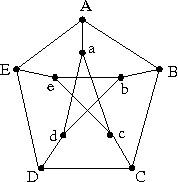Board problem: Use bubble sort to sort the list 5,1,3,4,2. Show all phases.
Bonus problems:
- State a linear programming problem whose integer valued solution finds a maximum matching in a bipartite graph. Show that the dual problem is related to finding a minimum edge cover. You may use the Linear Programming entry on Wikipedia as your reference.
- Prove that an n by n permutation matrix can not be written as the convex combination of other n permutation matrices.
Bonus problems:
- How can you find the degree of a vertex using the adjacency matrix? (Justify your answer.)
- Consider the following variant of the pitcher pouring puzzle. There are three bottles, of sizes 8 liters, 5 liters and 3 liters. Originally the 8 liter bottle is full, the other two are empty. A valid move consists of pouring wine from one bottle into the other, until the pouring bottle becomes empty or the receiving bottle becomes full. Use a geometric argument to describe the set of configurations that can be reached from the starting configuration.
Note: 2.4/8a has a typo. The correct inequality is:
 .
.
Our first test is on Monday September 28. You may downloand the Sample Test 1 I will distribute on Wednesday September 23.
Board problem: What is the chromatic number of the wheel graph with n+1 vertices? (Example 2.3 in Section 2.3 answers the question for n=6. You need to generalize that example. A wheel graph on n+1 vertices has one vertex in the center, connected to all other vertices. The vertices that are different from the center form a circuit of length n.)
Board problem: The Petersen graph is shown in the picture below.

Bonus problems:
- Prove that the edge graph of the n-dimensional hypercube is bipartite. (The vertices of the n-dimensional hypercube are all 01-strings of length n, two vertices are adjacent when exactly one of their coordinates differs.)
- Generalize Euler's formula to non-connected planar graphs (introduce a
variable c for the number of connected components.
- Show that allowing disconnected countries no fixed number of colors suffices to color all maps.